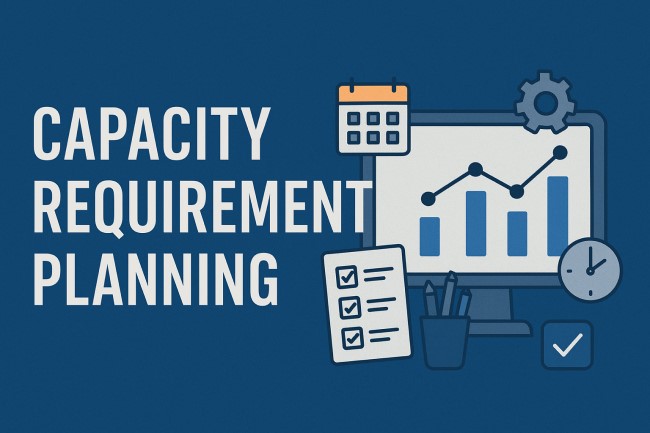Capacity Requirement Planning: A Complete Guide for Efficient Production

Introduction to Capacity Requirement Planning
Capacity Requirement Planning (CRP) is a vital process in manufacturing and production management. It ensures that a company’s available production capacity—such as labor, machines, and facilities—matches the demand set out in the production schedule. By comparing planned workloads with available capacity, CRP identifies potential gaps or surpluses, helping businesses adjust operations proactively.
In competitive industries, delivering products on time while optimizing resources is crucial. CRP helps organizations avoid bottlenecks, reduce idle time, and maintain customer satisfaction.
Understanding Capacity Requirement Planning
What is Capacity Requirement Planning?
Capacity Requirement Planning is a systematic process used to determine whether a company has the necessary resources to meet the demands of its production schedule. It is a detailed, short-term planning method that works alongside Material Requirements Planning (MRP) to ensure that production goals are achievable.
While MRP focuses on material availability, CRP focuses on the availability of production capacity. Together, they create a balanced approach to meeting demand without overburdening resources.
Key Objectives of CRP
-
Ensure the right amount of resources are available to meet production needs.
-
Identify capacity shortages or excesses early.
-
Enable efficient allocation of labor and equipment.
-
Support timely delivery of products to customers.
Importance of Capacity Requirement Planning
Avoiding Production Delays
One of the most critical benefits of CRP is preventing delays. When capacity planning is ignored, businesses risk failing to meet delivery deadlines due to overloaded work centers.
Optimizing Resource Utilization
CRP ensures resources are neither overused nor underused. Overcapacity leads to wasted resources, while undercapacity can result in unmet demand and dissatisfied customers.
Improving Decision-Making
With CRP, managers can make informed decisions about adjusting production schedules, adding extra shifts, hiring more staff, or investing in new equipment.
How Capacity Requirement Planning Works
Step 1: Analyze Current Capacity
The first step involves determining the existing production capacity, including labor hours, machine availability, and facility limitations.
Step 2: Review the Production Schedule
The production schedule, usually generated by the Master Production Schedule (MPS) or MRP, provides the planned workloads for specific timeframes.
Step 3: Compare Required vs. Available Capacity
CRP compares the workload from the production schedule with the available capacity. This step highlights where capacity is insufficient or excessive.
Step 4: Identify and Address Gaps
If capacity is insufficient, corrective actions might include increasing working hours, outsourcing certain tasks, or reassigning resources to high-priority jobs.
Step 5: Monitor and Adjust
CRP is not a one-time process. Continuous monitoring ensures the plan stays aligned with changing demand and production conditions.
Components of Capacity Requirement Planning
Work Centers
Work centers are specific locations or groups of machines where particular operations are carried out. CRP assesses the capacity of each work center individually.
Routing Data
Routing data outlines the sequence of operations required to produce a product. It includes operation times, work centers, and required resources.
Load Profiles
A load profile shows the amount of work assigned to a resource over time. This helps visualize workloads and detect potential overloads.
Levels of Capacity Planning
Rough-Cut Capacity Planning (RCCP)
RCCP provides a high-level view of capacity needs over a long-term horizon, based on the MPS. It helps in strategic planning but lacks the detail of CRP.
Detailed Capacity Requirement Planning
CRP offers a precise, short-term view, focusing on actual work orders, routing, and operation times. This level is crucial for daily and weekly production control.
Benefits of Capacity Requirement Planning
Improved Efficiency
By ensuring the right resources are in place at the right time, CRP improves overall production efficiency.
Reduced Costs
Avoiding overtime, unnecessary hiring, or equipment downtime reduces operational costs.
Enhanced Customer Satisfaction
Meeting delivery commitments consistently builds customer trust and loyalty.
Better Resource Allocation
CRP ensures resources are allocated to tasks with the highest priority, maximizing productivity.
Challenges in Capacity Requirement Planning
Data Accuracy
CRP depends heavily on accurate data regarding resource availability, production times, and schedules. Incorrect data can lead to poor planning decisions.
Unexpected Changes
Sudden equipment breakdowns, labor shortages, or urgent customer orders can disrupt capacity plans.
Integration with Other Systems
CRP works best when integrated with MRP, ERP, and other production systems. Poor integration can limit its effectiveness.
Best Practices for Effective CRP
Maintain Accurate Data
Ensure that work center capacities, operation times, and schedules are regularly updated and accurate.
Use Reliable Software
Modern ERP systems with CRP modules provide automated calculations, real-time updates, and better decision-making support.
Plan for Contingencies
Include buffer capacity or backup plans for unexpected disruptions.
Regularly Review and Adjust
CRP should be a continuous process, adapting to changes in demand, workforce availability, and equipment performance.
Capacity Requirement Planning in Modern Manufacturing
Role in Lean Manufacturing
In lean manufacturing, CRP supports just-in-time production by aligning capacity closely with actual demand, reducing waste and inventory costs.
Integration with Digital Tools
With Industry 4.0 advancements, CRP systems can now integrate with IoT devices, predictive analytics, and AI to forecast capacity issues before they occur.
Conclusion
Capacity Requirement Planning is an essential process for ensuring that a company’s production capacity meets the demands of its schedule. By providing detailed, short-term capacity analysis, CRP helps prevent production bottlenecks, improve efficiency, and enhance customer satisfaction.
When implemented effectively—with accurate data, reliable tools, and continuous monitoring—CRP becomes a powerful tool for maintaining operational excellence in manufacturing. Businesses that invest in proper capacity planning position themselves to deliver consistently, compete effectively, and grow sustainably.



